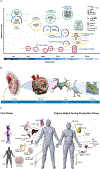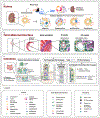Advances and prospects for the Human BioMolecular Atlas Program (HuBMAP)
- PMID: 37468756
- PMCID: PMC10681365
- DOI: 10.1038/s41556-023-01194-w
Advances and prospects for the Human BioMolecular Atlas Program (HuBMAP)
Erratum in
-
Author Correction: Advances and prospects for the Human BioMolecular Atlas Program (HuBMAP).Nat Cell Biol. 2024 May;26(5):839. doi: 10.1038/s41556-024-01384-0. Nat Cell Biol. 2024. PMID: 38429479 Free PMC article. No abstract available.
Abstract
The Human BioMolecular Atlas Program (HuBMAP) aims to create a multi-scale spatial atlas of the healthy human body at single-cell resolution by applying advanced technologies and disseminating resources to the community. As the HuBMAP moves past its first phase, creating ontologies, protocols and pipelines, this Perspective introduces the production phase: the generation of reference spatial maps of functional tissue units across many organs from diverse populations and the creation of mapping tools and infrastructure to advance biomedical research.
© 2023. Springer Nature Limited.
Conflict of interest statement
Competing Interests
The authors declare the following competing interests.
F.G. are employees of GE Research. B.R.S. is an inventor on patents and patent applications involving small molecule drug discovery, and the 3F3-FMA antibody, co-founded and serves as a consultant to Inzen Therapeutics, Nevrox Limited, Exarta Therapeutics, and ProJenX Inc.; and serves as a consultant to Weatherwax Biotechnologies Corporation and Akin Gump Strauss Hauer & Feld LLP. M.P.S. is cofounder and advisory board member of Personalis, Qbio, January AI, Mirvie, Filtricine, Fodsel, Lollo, and Protos. I.S.V. consults for Guidepoint Global, Cowen, Mosaic, and NextRNA. N.G. is a co-founder and equity owner of Datavisyn. H.L. is a co-founder and equity owner of ExoMira Medicine, Inc. The remaining authors declare no competing interests.
Figures




References
-
- HuBMAP Data Portal. https://portal.hubmapconsortium.org/.
Publication types
Grants and funding
- UH3 CA246635/CA/NCI NIH HHS/United States
- T32 GM136577/GM/NIGMS NIH HHS/United States
- U54 HD104393/HD/NICHD NIH HHS/United States
- UG3 CA256967/CA/NCI NIH HHS/United States
- OT2 OD026671/OD/NIH HHS/United States
- K12 HD105271/HD/NICHD NIH HHS/United States
- U54 HL145608/HL/NHLBI NIH HHS/United States
- R01 AR074285/AR/NIAMS NIH HHS/United States
- T32 CA196585/CA/NCI NIH HHS/United States
- U24 CA268108/CA/NCI NIH HHS/United States
- UG3 CA256959/CA/NCI NIH HHS/United States
- U01 HG012680/HG/NHGRI NIH HHS/United States
- R01 AR079233/AR/NIAMS NIH HHS/United States
- U24 DK135157/DK/NIDDK NIH HHS/United States
- P50 DK133943/DK/NIDDK NIH HHS/United States
- U54 DK134302/DK/NIDDK NIH HHS/United States
- R01 DK123329/DK/NIDDK NIH HHS/United States
- U54 HL165443/HL/NHLBI NIH HHS/United States
- U54 DK120058/DK/NIDDK NIH HHS/United States
- U54 DK127823/DK/NIDDK NIH HHS/United States
- U2C DK114886/DK/NIDDK NIH HHS/United States
- R01 CA245699/CA/NCI NIH HHS/United States
- U54 AR081775/AR/NIAMS NIH HHS/United States
- U01 DK114933/DK/NIDDK NIH HHS/United States
- U54 HL145611/HL/NHLBI NIH HHS/United States
- OT2 OD033756/OD/NIH HHS/United States
- U01 HL166060/HL/NHLBI NIH HHS/United States
- U01 HL166058/HL/NHLBI NIH HHS/United States
- U54 HL165440/HL/NHLBI NIH HHS/United States
- U54 HG010426/HG/NHGRI NIH HHS/United States
- U54 DK134301/DK/NIDDK NIH HHS/United States
- R01 HL157991/HL/NHLBI NIH HHS/United States
- U54 EY032442/EY/NEI NIH HHS/United States
- UH3 CA246633/CA/NCI NIH HHS/United States
- U24 DK114886/DK/NIDDK NIH HHS/United States
- OT2 OD033758/OD/NIH HHS/United States
- U54 HL165442/HL/NHLBI NIH HHS/United States
- UH3 CA246594/CA/NCI NIH HHS/United States
- OT2 OD033753/OD/NIH HHS/United States
LinkOut - more resources
Full Text Sources
Research Materials
Miscellaneous

